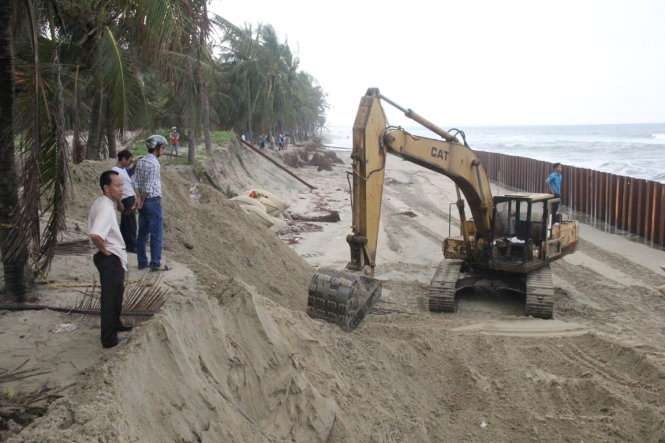Experts and authorities in a central Vietnamese city that houses a UNESCO-recognized old town have been spooked by the grim prospect that a stunning beach along its coastline could disappear altogether due to alarming soil erosion.
Cua Dai Beach, which is a gem of Hoi An City's tourist industry and a major draw to international tourists, is being wiped out by sea waves at an alarming rate.
Located in Quang Nam Province, Hoi An City includes the famous Hoi An Ancient Town that was declared a World Heritage Site by UNESCO in 1999.
The beach has seen relentless, devastating coastal erosion since October last year, with the damage spiraling out of control recently.

A dyke section along Cua Dai Beach gave way in September 2013. Photo: Tuoi Tre
Experts at several seminars held to address the issue have unanimously agreed that the malady is mostly put down to hydroelectric dams, which block the silt and sand currents from upstream, and rampant sand mining along the Vu Gia-Thu Bon, a major river system in the area.
Associate Professor Vu Thanh Ca, of the Vietnam Administration of Seas and Islands, dismissed climate change as the culprit of the coastal erosion.
“The water level rise at Cua Dai Beach is around 30 centimeters, which causes considerably less extensive erosion than it is now,” he noted.
Assoc. Prof. Ca then said that the massive change in the sand volume, mostly along the Vu Gia-Thu Bon Rivers, is to blame for the situation.
In recent times, the rivers and their tributaries, such as Vinh Dien and Chim, have crawled with sand mines, which operate at full capacity to supply the material for mushrooming building sites in the neighborhood.
According to Bui Van Ba, of the Quang Nam Department of Natural Resources and Environment, 15 units have obtained permits to exploit sand along the Vu Gia-Thu Bon Rivers, while 40 others are currently applying for such licenses.
Over the past three years, the area has also seen a surge in the number of hydroelectric dams built upstream on the rivers, which has resulted in a sharp rise in the volume of sand and mud on the riverbeds.
According to a recent report released by the provincial People’s Committee, the Vu Gia-Thu Bon Rivers are now home to 10 terraced hydroelectric plants, with 32 other medium and small plants in their proximity.
“The reservoirs upstream block a huge volume of sand and mud and cause a serious shortage of sand and mud at the estuaries. It’s the hidden culprit of coastal erosion in Hoi An,” Assoc. Prof. Ca concluded.
Professor Hitoshi Tanaka, from Japan’s Tohoku University, endorsed Assoc. Prof. Ca’s hypothesis, stressing that the upstream system has a lot to do with the erosion.
The alarming coastal erosion has dealt a devastating blow to the owners of the luxury resorts along the coast and adversely impacted their business.
Several construction sites at resorts have been swallowed by waves, bringing work to a complete standstill.
Sea water is on the verge of encroaching on the resorts’ properties, putting their potential clients off spending their stays there.
The resort owners have taken matters into their own hands by erecting dozens of steel poles in the area to act as dykes.
Hundreds of sand sacks are placed on coconut tree bases to boost soil retention.

Locals keep a vigilant watch on a dyke section along Cua Dai Beach that gave way in September 2013. Photo: Tuoi Tre
However, the spontaneous dyke erection also backfires, causing unsightly spectacles and aggravating the soil attrition in the neighboring areas, according to Dr. Le Dinh Mau, of the Nha Trang Institute of Oceanography in the south-central province of Khanh Hoa.
For instance, the northern zone of Cua Dai Beach has incurred the most worrying damage partly due to the protective structures around the beach resorts on Au Co and Lac Long Quan Streets, Dr. Mau added.
“The beaches, and Cua Dai in particular, make up half of Hoi An’s tourism appeal, so the loss of Cua Dai Beach will adversely impact the city’s economic growth,” Nguyen Su, the Hoi An City Party Committee secretary, noted.
The corrosion has also taken a toll on the area’s coastal culture, as land being eaten away has pushed residents further ashore, which gnaws at their time-honored fishing and sea-related cultural traditions.
Long-running solutions needed
Assoc. Prof. Ca, of the Vietnam Administration of Seas and Islands, urged that all sand mining activity be strictly banned in the downstream areas of the Thu Bon River and on the province’s entire coastline.
Specialized dykes should be built to shield Cua Dai Beach from further attrition, he suggested.
Meanwhile, Assoc. Prof. Tran Thanh Tung, of Hanoi-based Thuy Loi University, proposed sand be ‘cultivated’ to make amends for the lost volume.
Local scientists also called for cultivating protective forests and exerting more soil retention efforts.
Nguyen Van Hien, head of the Hoi An City Office of Natural Resources and Environment, told Tuoi Tre (Youth) newspaper that the city is mulling setting up specialized dykes and running ‘sand farms’ at the same time to combat the erosion.

Part of the gorgeous Cua Dai Beach. Photo: Tuoi Tre
Like us on Facebook or follow us on Twitter to get the latest news about Vietnam!


















































